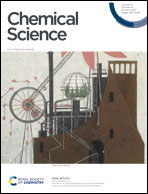A rare isocyanide derived from an unprecedented neutral yttrium(ii) bis(amide) complex†
Abstract
A room temperature stable complex formulated as Y(NHAr*)2 has been prepared, where Ar* = 2,6-(2,4,6-(iPr)3C6H2)C6H3, by KC8 reduction of ClY(NHAr*)2. Based on EPR evidence, Y(NHAr*)2 is an example of a d1 Y(II) complex with significant delocalization of the unpaired electron density from the metal to the ligand. The isolation of molecular divalent metal complexes is challenging for rare earth elements such as yttrium. In fact, stabilization of the divalent state requires judicious ligand design that allows the metal center to be coordinatively saturated. Divalent rare earth elements tend to be reactive towards various substrates. Interestingly, Y(NHAr*)2 reacts as a radical donor towards tBuNC to generate an unusual yttrium isocyanide complex, CNY(NHAr*)2, based on spectroscopic evidence and single-crystal X-ray diffraction data.

- This article is part of the themed collection: 2023 Chemical Science Covers


 Please wait while we load your content...
Please wait while we load your content...